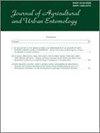Greater Wax Moth Larvae Can Complete Development on Paper Wasp Nest1
Q2 Agricultural and Biological Sciences
引用次数: 4
Abstract
Two wax moth species cause damage to honey bee combs: 1) the lesser wax moth, Achoria grisella (F.), and 2) the greater wax moth, Galleria mellonella (L.) (Lepidoptera: Pyralidae). These species differ in appearance, biology, and life cycle (Ellis et al. 2013). Colonies infested with wax moths suffer damage to wax combs, prevention of adult bee emergence from cells, and increased tendencies of infested colonies to abscond (Ellis et al. 2013, Tsegaye et al. 2014). Therefore, various control methods for wax moths have been developed especially for stored combs. These methods include using paradichlorbenzene crystals (Burges 1978), and heat treatments (Charrière & Imdorf 1999). Recently, non-chemical traps to reduce damages from wax moths inside beehives have been developed (Abou-Shaara 2017). Also, sex pheromone traps (Sangramsinh et al. 2014) and light traps (Mabrouk & Mahbob 2015) can be used to trap wax moths outside the beehives. The known natural food for wax moths is beeswax. Beeswax from all Apis species is suitable for wax moth larval development, but the combs of Apis cerana (F.) and Apis dorsata (F.) (Hymenoptera: Apidae) are the most preferable for female moth fecundity and larval growth (Swamy et al. 2009). Under laboratory conditions, wax moths can be reared using artificial diets prepared with different materials, e.g., yeast, glucose, and honey (Akbar et al. 2004), or other meridic materials such as wheat flour, corn flour, and milk powder (Singh et al. 2014). Wax moths can utilize different materials as food sources in laboratory settings. However, beeswax is believed to be the wax moth’s only food source in nature. Paper wasps (Polistes spp.; Hymenoptera: Vespidae) are able to build their nests at different, sometimes unexpected, locations, e.g., inside plastic bee feeders. A paper wasp nest is composed of composite fibers from plant stems, leaves and woods. Honey bees and paper wasps belong to the same taxonomic order (Hymenoptera), both are social insects, and have the ability to build nests. Moreover, some common genetic roots were found between honey bees and paper wasps (Toth et al. 2010). Spatial and evolutionary proximity between honey bee and paper wasp nests may allow the wax moth to utilize nests of social wasps other than those of honey bees. Indeed, Grabe (1942) reported on the utilization of wasp nests by G. mellonella. I大蜡蛾幼虫可在纸蜂窝上完成发育1
对蜂巢造成危害的蜡蛾有两种:1)小蜡蛾(Achoria grisella, F.)和2)大蜡蛾(Galleria mellonella, L.)(鳞翅目:蚜科)。这些物种在外观、生物学和生命周期上都有所不同(Ellis et al. 2013)。被蜡蛾侵染的蜂群受到蜡蜂巢的破坏,成蜂无法从蜂房中羽化,而且被侵染的蜂群逃跑的倾向增加(Ellis et al. 2013, Tsegaye et al. 2014)。因此,人们开发了各种防治蜡蛾的方法,特别是针对储存的梳子。这些方法包括使用对二氯苯晶体(Burges 1978)和热处理(charri & Imdorf 1999)。最近,已经开发了非化学陷阱来减少蜂箱内蜡蛾的损害(abu - shaara 2017)。此外,性信息素诱捕器(Sangramsinh et al. 2014)和光诱捕器(Mabrouk & Mahbob 2015)可用于诱捕蜂箱外的蜡蛾。众所周知,蜡蛾的天然食物是蜂蜡。所有蜜蜂种类的蜂蜡都适合于蜡蛾幼虫的发育,但中国蜜蜂(Apis cerana, F.)和意大利蜜蜂(Apis dorsata, F.)(膜翅目:蜂科)的蜂蜡最适合于雌蛾的繁殖力和幼虫的生长(Swamy et al. 2009)。在实验室条件下,可以用不同材料配制的人工饲料饲养蜡蛾,如酵母、葡萄糖和蜂蜜(Akbar等人,2004年),也可以用其他经纬材料,如小麦粉、玉米粉和奶粉(Singh等人,2014年)。在实验室环境中,蜡蛾可以利用不同的材料作为食物来源。然而,蜂蜡被认为是蜡蛾在自然界中唯一的食物来源。纸黄蜂(Polistes科);膜翅目:蜂科)能够在不同的,有时是意想不到的地方筑巢,例如,在塑料蜜蜂喂食器里。纸蜂窝是由植物茎、叶和木材的复合纤维组成的。蜜蜂和纸黄蜂属于同一个分类学目(膜翅目),都是群居昆虫,都有筑巢的能力。此外,在蜜蜂和纸黄蜂之间发现了一些共同的遗传根源(Toth et al. 2010)。蜜蜂和纸黄蜂的巢在空间和进化上的接近可能使蜡蛾利用群居黄蜂的巢而不是蜜蜂的巢。事实上,Grabe(1942)报道了大黄蜂对胡蜂巢的利用。我
本文章由计算机程序翻译,如有差异,请以英文原文为准。
求助全文
约1分钟内获得全文
求助全文
来源期刊

The Journal of Agricultural and Urban Entomology
Agricultural and Biological Sciences-Insect Science
CiteScore
1.40
自引率
0.00%
发文量
2
期刊介绍:
The Journal of Agricultural and Urban Entomology (JAUE) (Journal of Agricultural Entomology, Jan 1984 - Oct 1998 volumes 1-15) is published under the auspices of the South Carolina Entomological Society (SCES). The Journal publishes contributions of original research concerning insects and other arthropods of agricultural and urban importance to include those affecting humans, livestock, poultry, and wildlife. JAUE is particularly dedicated to the publication of articles and notes pertaining to applied entomology, although it will accept suitable contributions of a fundamental nature related to agricultural and urban entomology.
 求助内容:
求助内容: 应助结果提醒方式:
应助结果提醒方式:


